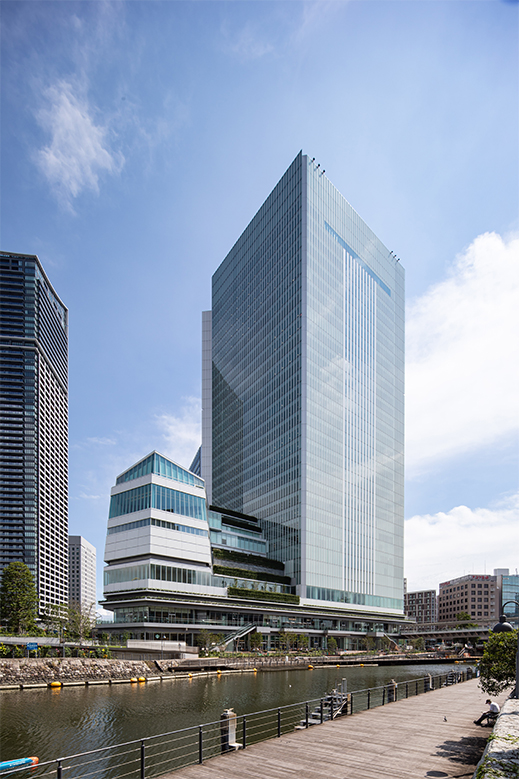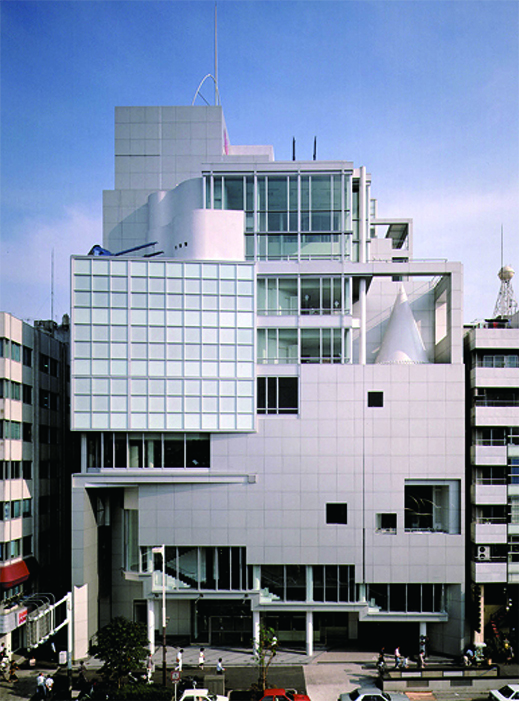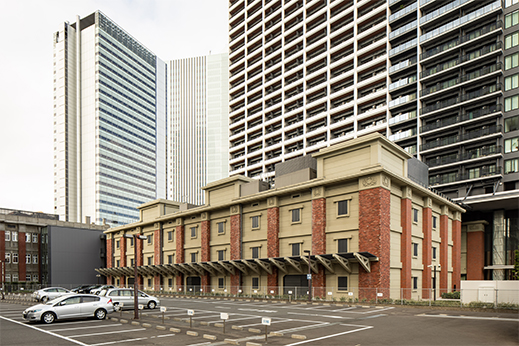 |
Focus features two in-depth reviews each month of fine art, architecture, and design exhibitions at art museums, galleries, and alternative spaces around Japan. |
|
|
 |
 |
 |
Yokohama Legacy: A City Pays Tribute to Two Visionary Architects
James Lambiasi |
 |
Exterior view of BankArt Temporary, a former bank. Photo: BankArt 1929
|
Yokohama has been a city of visionary architecture ever since its founding in 1859, and this is clearly evident in its evolution into a vibrant urban center. Originally established as the first port in Japan to officially welcome international trade, it has continued to lead the way in urban planning by preserving its valuable history while looking toward the future through innovative design. There are two great Japanese architects who have contributed to this accomplishment: Togo Murano and his successor by one generation, Fumihiko Maki. In fact, 2020 marks an important milestone in their relationship with Yokohama, as the new Yokohama City Hall, designed by Maki, was inaugurated this year, and an ambitious development is being planned for repurposing the former Yokohama City Hall, which was designed by Murano. In commemoration of both architects' achievements, BankArt 1929 has organized M Meets M: Togo Murano Exhibition and Fumihiko Maki Exhibition.
 |
|
Models of works by Togo Murano. Photo: BankArt 1929
|
Interior view, Fumihiko Maki Exhibition. Photo: BankArt 1929
|
BankArt 1929 is the ideal venue to showcase the work of Murano and Maki because it also represents the advanced urban planning ethos of this city. Initiated in 2004 by the Yokohama City government as part of the Creative City Initiative, it is a project designed to revitalize the heart of the city by utilizing historic structures for the purpose of promoting contemporary culture and the arts. The dual M Meets M exhibitions are being held in two BankArt venues: the Togo Murano Exhibition at BankArt Kaiko (the former Imperial Silk Warehouse), and the Fumihiko Maki Exhibition across the street at BankArt Temporary (the former Daiichi Bank).
View of the Administrative Building, Former Yokohama City Hall (1959), by Togo Murano. Photo: Yasushi Ichikawa
|
Togo Murano is known as one of the Modernist masters of Japanese architecture, with a career spanning the decades from the 1920s to the 1980s. The exhibition at BankArt Kaiko provides a rare opportunity to view his works through detailed models, photos, original drawings -- and, most impressively, full-scaled sketches of many of his famous details. While I was personally interested to see works with which I am familiar, such as the World Peace Cathedral in Hiroshima (1953), the Nissay Hibiya Building (1963), and the Hakone Prince Hotel (currently The Prince Hakone Ashinoko) (1978), the show provides an extremely comprehensive view by also including lesser-known buildings that trace the path of Murano's design evolution.
Interior view of the Nissay Theatre, Nissay Hibiya Building (1963), by Togo Murano. Photo: Yasushi Ichikawa
|
A highlight of the Murano show is the former Yokohama City Hall (1959), which is one of a very few government buildings by Murano and is considered one of his most representative works. Designed to commemorate the 100th anniversary of the 1859 opening of the Port of Yokohama, it has played a significant role in the central area of the city both historically and aesthetically as a modern masterpiece blending in seamlessly with its surrounding historic structures. Currently the building is part of an ambitious repurposing development and will serve as a future business innovation center.
While Togo Murano completed his final works in the early 1980s and died in 1984, the mantle of modern design had already passed to the next generation of architects such as Fumihiko Maki, who by this time had already established himself on the international stage with a prolific number of notable buildings. Like the Murano show, the Maki exhibition at BankArt Temporary offers a valuable opportunity to view his works through detailed models, photos, original drawings, and meticulous detail drawings. Among the exhibits are works that catapulted him to world acclaim, such as Hillside Terrace Complex I-IV (1969-1992), the Spiral in Omotesando (1985), and Tokyo Metropolitan Gymnasium (1990), as well as the more recent 4 World Trade Center (2013) in New York City.
 |
|
 |
|
|
|
|
Yokohama City Hall (2020), by Fumihiko Maki.
Photo: BankArt 1929
|
|
Spiral Building (1985), by Fumihiko Maki.
Photo: Toshiharu Kitajima |
Maki has established a close connection with Yokohama through his engagement in major urban planning projects that include the well-known Minato Mirai District, and Yokohama City wisely chose him to design their new Yokohama City Hall. To inaugurate the building's opening this year, the Maki exhibition goes beyond typical architectural displays by providing exhibits that go into great detail about the design process -- such as sample presentation boards used in actual presentations -- to convey the painstaking planning work involved in a community project like Yokohama City Hall.
In addition to seeing the buildings of Murano and Maki within their respective exhibitions, please note that both the former and current Yokohama City Halls are just a stone's throw away. After experiencing both shows, I highly recommend that you walk through central Yokohama, where you can see both buildings in the vibrant setting of a city that has preserved its valuable history while continuing to boldly reinvent itself for the future.
 |
|
Exterior view of BankArt Kaiko, a former silk warehouse. Photo: BankArt 1929 |
All images by permission of BankArt 1929. |
 |
 |
James Lambiasi
Following completion of his Master's Degree in Architecture from Harvard University Graduate School of Design in 1995, James Lambiasi has been a practicing architect and educator in Tokyo for over 26 years. He is the principal of his own firm James Lambiasi Architect, has taught as a visiting lecturer at several Tokyo universities, and has lectured extensively on his work. James has served as president of the AIA Japan Chapter in 2008, and frequently appears on the NHK series "Journeys in Japan" as an architectural critic. |
|
 |
|